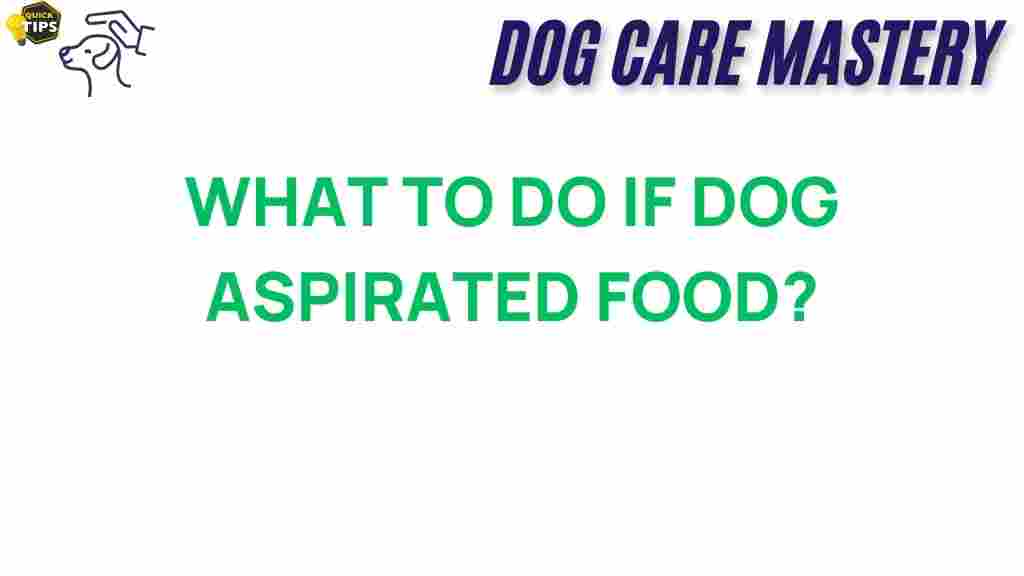What to Do If Your Dog Aspirates Food: Understanding Dog Aspiration
Dog aspiration is a serious condition that occurs when food or liquid enters a dog’s airway instead of the esophagus. This can lead to choking, respiratory issues, or even pneumonia. As a responsible pet owner, it’s essential to understand what to do if your furry friend experiences this problem. In this guide, we will walk you through the necessary steps to take if your dog aspirates food, how to recognize the signs, and what preventive measures you can implement to avoid future incidents.
Recognizing the Signs of Dog Aspiration
Before diving into the steps to take if your dog aspirates food, it’s crucial to recognize the signs of aspiration. Early detection can make a significant difference in your dog’s health. Look out for the following symptoms:
- Coughing or gagging after eating
- Difficulty breathing or labored breathing
- Unusual vocalizations, such as wheezing or honking
- Excessive drooling
- Blue-tinged gums or tongue (indicative of low oxygen levels)
- Lethargy or decreased activity level
If you notice any of these symptoms, it’s essential to act quickly. Early intervention can prevent further complications associated with dog aspiration.
Step-by-Step Process for Handling Dog Aspiration
If you suspect that your dog has aspirated food, follow these steps:
1. Stay Calm
Your dog will likely pick up on your anxiety. Staying calm will help you think clearly and act quickly.
2. Assess the Situation
Check if your dog is able to breathe and is conscious. If your dog is still breathing but coughing, they may be trying to expel the food on their own.
3. Clear the Airway
If your dog is struggling to breathe, you may need to perform the following:
- **Heimlich Maneuver**: For small dogs, hold them with their back against your chest and place your fist just below the ribcage. Give a firm thrust inward and upward. For larger dogs, position your arms around their waist and thrust inward and upward.
- **Finger Sweep**: If you can see the obstruction in your dog’s mouth, you may attempt to remove it with your fingers. Be cautious to avoid pushing it further down the throat.
4. Monitor Breathing
After attempting to clear the airway, monitor your dog’s breathing. If they are still having difficulty, it may be time to seek professional help.
5. Contact Your Veterinarian
Regardless of whether you successfully clear the obstruction, it’s essential to contact your veterinarian as soon as possible. They may recommend bringing your dog in for an examination to check for any damage or complications from the aspiration.
Troubleshooting and Preventive Tips
Understanding the causes of dog aspiration can help you prevent future incidents. Here are some troubleshooting tips and preventive measures:
1. Choose Appropriate Food
Some dog foods, particularly dry kibble, can be difficult for certain dogs to chew and swallow properly. Consider softer food options or those designed for specific breeds or sizes. Consult your veterinarian for recommendations.
2. Monitor Mealtime
Always supervise your dog while they eat. If they tend to eat too quickly, try the following:
- Use a slow feed bowl to encourage slower eating.
- Feed smaller portions more frequently.
- Hand-feed your dog if necessary.
3. Avoid Distractions
Minimize distractions during mealtime. This includes keeping other pets away and creating a quiet environment. Distractions can lead to rushed eating and increases the risk of aspiration.
4. Train Your Dog
Basic obedience training can help your dog focus during mealtime. Teaching commands like “slow” or “easy” can encourage them to take their time when eating.
5. Regular Veterinary Check-ups
Routine veterinary visits can help identify any underlying health issues that may predispose your dog to aspiration, such as dental problems or respiratory issues. Ensure your dog is healthy and fit for mealtime.
When to Seek Emergency Help
It’s vital to know when your dog needs immediate medical intervention. If you notice any of the following signs, take your dog to the vet or an emergency animal clinic right away:
- Severe difficulty breathing or persistent coughing
- Unconsciousness or unresponsiveness
- Continuous gagging or choking
- Bleeding from the mouth or nose
In these situations, every second counts. Early intervention can save your dog’s life.
Conclusion
Dog aspiration is a serious condition that requires immediate attention. By understanding the signs and knowing the steps to take if your dog aspirates food, you can protect your furry friend from potential harm. Always prioritize your dog’s health and consult your veterinarian for personalized advice and care. For more information on pet health and safety, visit this resource.
Remember, preventive measures can significantly reduce the risk of aspiration. Monitor mealtime, choose appropriate food, and train your dog to eat more slowly. With these strategies, you can help keep your dog safe and happy.
If you have any further questions or concerns regarding dog aspiration or your dog’s health, don’t hesitate to reach out to your veterinarian or check out this informative article for more insights.
This article is in the category Safety and created by dogcaremastery Team
